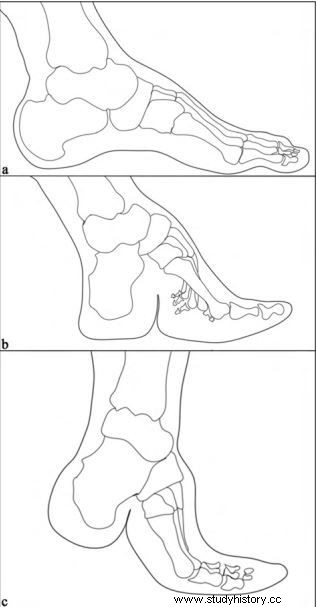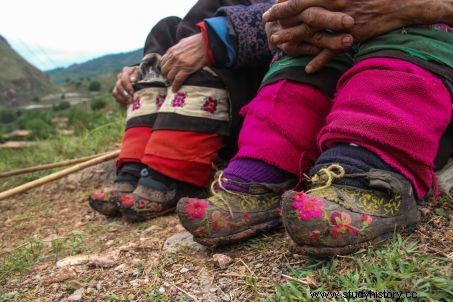The analysis of the skeletons of a necropolis of the Qing dynasty (1642-1912), discovered in Shanxi, in China, makes it possible to return to the painful custom of bound feet. A practice of female mutilation that will have lasted 1000 years!

"Lotus d'or" shoes for bound feet not to exceed...7.5 cm. A dramatic custom practiced in China from the 10th century to the 20th century.
"WILLOW". For centuries, the suffering of women has had its master standard in the Middle Kingdom. "To stagger like the willow" , you had to have bound feet to prevent their growth. This terrible custom, which appeared in the 10th century - with, however, a few possible cases in Jiangsu as early as the Han dynasty (206 BC-220 AD) - had become a canon of beauty for the aristocracy. It imposed itself first at the court of the Tang (618-907) and the Song (960-1279), before spreading to all the other strata of society, in particular under the Ming (1368-1644). ) and the Qing (1644-1912). Thus, in Han families (the majority ethnic group in China), a thousand pains were inflicted on young girls to ensure their social future by guaranteeing their marriage into more fortunate upper-class families. To reach this apogee and be a "Golden Lotus", it was thus necessary to have feet that did not exceed 7.5 cm long, 10 cm to be a "Silver Lotus", and 12 cm for the " Iron Lotus"...
 Anatomy of a bound foot (left) vs a natural foot (right). ©Qian Wang et al.
Anatomy of a bound foot (left) vs a natural foot (right). ©Qian Wang et al.
74 women with bound feet
The recent study of a cemetery from the Qing dynasty (1644-1912) discovered in northern China in Hongtong county and Shanxi province, has just been the subject of a scientific publication in the journal Archaeological and Anthropological Sciences . "In this necropolis of Xifengbu, seventy-four women had their feet bound among the remains of the ninety-three found , explains Qian Wang, researcher at Texas A&M University (USA), co-signer of the article, joined by Sciences et Avenir . They are aged between 13 and 60 and belonged to two families who buried their dead in this cemetery for several centuries, the Liu and the Zhao" .
 Burial of a woman with bound feet found in the Qing dynasty necropolis of Xifengu, Shanxi (China). ©Qian Wang et al.
Burial of a woman with bound feet found in the Qing dynasty necropolis of Xifengu, Shanxi (China). ©Qian Wang et al.
A boon for the scientists, who were able to carry out a comparative study over the long term. This confirmed what the historical chronicles relayed, namely that women with bound feet had a higher economic status than those with natural feet. "It is nevertheless interesting to note that a few women with unbound feet were still buried in the same way as those with bound feet during the Qing period (1644-1912)" . These evaluations could be established according to the epitaphs and the importance of the funerary objects collected in the tombs.
"WILLOW". For centuries, the suffering of women had its benchmark in the Middle Kingdom. "To stagger like the willow" , you had to have bound feet to prevent their growth. This terrible custom appeared in the X e century - with however some possible cases in Jiangsu from the Han dynasty (206 BC-220 AD) - had become a canon of beauty for the aristocracy. It imposed itself first at the court of the Tang (618-907) and the Song (960-1279), before spreading to all the other strata of society, in particular under the Ming (1368-1644). ) and the Qing (1644-1912). Thus, in Han families (the majority ethnic group in China), a thousand pains were inflicted on young girls to ensure their social future by guaranteeing their marriage into more fortunate upper-class families. To reach this apogee and be a "Golden Lotus", it was thus necessary to have feet that did not exceed 7.5 cm long, 10 cm to be a "Silver Lotus", and 12 cm for the " Iron Lotus"...
 Anatomy of a bound foot (left) vs a natural foot (right). ©Qian Wang et al.
Anatomy of a bound foot (left) vs a natural foot (right). ©Qian Wang et al.
74 women with bound feet
The recent study of a cemetery from the Qing dynasty (1644-1912) discovered in northern China in Hongtong county and Shanxi province, has just been the subject of a scientific publication in the journal Archaeological and Anthropological Sciences . "In this necropolis of Xifengbu, seventy-four women had their feet bound among the remains of the ninety-three found , explains Qian Wang, researcher at Texas A&M University (USA), co-signer of the article, joined by Sciences et Avenir . They are aged between 13 and 60 and belonged to two families who buried their dead in this cemetery for several centuries, the Liu and the Zhao" .
 Burial of a woman with bound feet found in the Qing dynasty necropolis of Xifengbu, Shanxi (China). ©Qian Wang et al.
Burial of a woman with bound feet found in the Qing dynasty necropolis of Xifengbu, Shanxi (China). ©Qian Wang et al.
A boon for the scientists, who were able to carry out a comparative study over the long term. This confirmed what the historical chronicles relayed, namely that women with bound feet had a higher economic status than those with natural feet. "It is nevertheless interesting to note that a few women with unbound feet were still buried in the same way as those with bound feet during the Qing period (1644-1912)" . These evaluations could be established according to the epitaphs and the importance of the funerary objects collected in the tombs.
 The Han Cemetery in Xifengbu, Shanxi Province, northern China. In red, the tombs of women with bound feet, in blue, those with undeformed feet. The dotted lines mark the graves of the Liu and Zhao families. ©Qian Wang et al.
The Han Cemetery in Xifengbu, Shanxi Province, northern China. In red, the tombs of women with bound feet, in blue, those with undeformed feet. The dotted lines mark the graves of the Liu and Zhao families. ©Qian Wang et al.
Necrosis of the toes
The examination of their feet was completed by the analysis of X-ray images of the remains of 241 women from different cemeteries scattered in four Chinese provinces (Fujian, Shaanxi, Shandong and Yunnan). It reveals the existence of two main types of anatomical deformities:Talipes calcaneus , characterized by a chunky heel with the 2 e and the 5 th toes folded inwards on the sole of the foot to reduce its length (80% of cases recorded in Xinfengbu cemetery), and the Talipes equinus , the foot having been deformed into steps. At each stage, the feet were placed in ever smaller pointed shoes. This veritable torture, beginning in little girls between the ages of 4 and 8, impaired the natural growth of the bones, and the tissue bandages, tightened as the foot grew, was a source of terrible torment and pain. It was not uncommon for the toes, thus compressed to the point of no longer being irrigated by blood, to become necrotic and fall off. These injuries could lead to fatal sepsis in 10% of cases.
 Comparative diagrams between a natural foot (a), a bandaged foot with Talipes Calcaneus (b), and Talipes Equinus (c). ©Qian Wang and alii
Comparative diagrams between a natural foot (a), a bandaged foot with Talipes Calcaneus (b), and Talipes Equinus (c). ©Qian Wang and alii
These sufferings endured were, according to the beliefs of the time, closely associated with pleasure and sexuality. According to tradition, walking with small atrophied feet was supposed to have an erotic effect on men. A legend, dated X e century, wanted women's feet "to be thin, small, bandaged, perfumed and symmetrical" , like those of the lotus dancer Yao Niang, according to Chinese historian Fudan Gaoxing. But this custom, which became the expression of Han identity, was above all a means of control by men over women, in a deeply patriarchal society.
 A woman with a "Golden Lotus", photographed in China at the end of the 19th century
e
century. ©AFP
A woman with a "Golden Lotus", photographed in China at the end of the 19th century
e
century. ©AFP
Periodic attempts to ban this practice, as the Manchus had attempted to do in the 17th century century, were long doomed to failure. It was not until 1912 that the Republic of China banished it, its eradication not having really taken place until the 1940s.
 The practice of foot binding was completely eradicated in 1949, but old ladies victimized by this tradition still lived in rural areas of Yunnan in 2015. ©He Huan / Imaginechina/AFP
The practice of foot binding was completely eradicated in 1949, but old ladies victimized by this tradition still lived in rural areas of Yunnan in 2015. ©He Huan / Imaginechina/AFP
It was not until 1949 that the People's Republic of China, considering this practice as degrading, formally prohibited it. Women with bound feet then had to suffer bullying, a double punishment for those women sent to the fields when they could barely walk. In 2015, there were still some old ladies with bound feet in Yunnan Province. A few may still be alive today.
